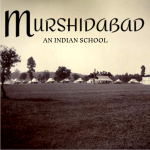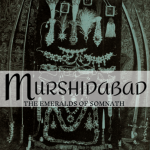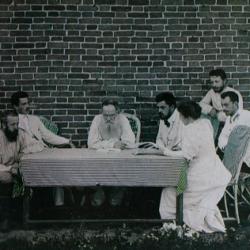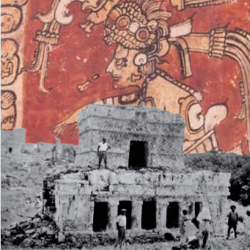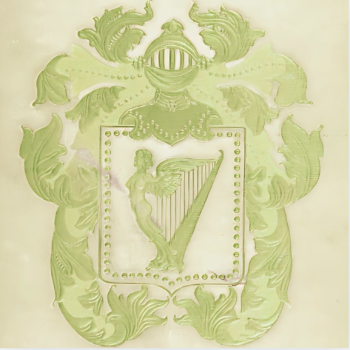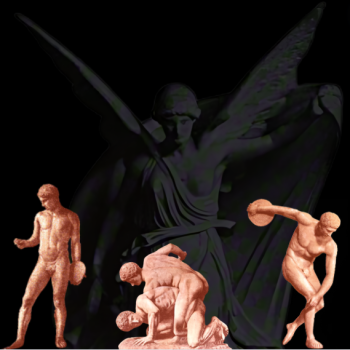THE BENGAL BAZAAR
Charles Johnston.
November 1889.
India is a ruin, beautiful only by moonlight; and, like a ruined temple, old India’s beauties dwell no longer in perfect design and harmonious unity, but linger in fragments and details—a shattered architrave, a broken capital, “cornice or frieze with bossy sculpture graven.”
The dying genius of India soars no more to broad and lofty conceptions; her failing inspiration is dwarfed and stunted to curious and minute beauties, intricate ivories, quaint enamels, and mosaic miniatures. Where ancient India’s sculptors hewed the giant bas-reliefs from Elephanta’s rocks, and cut the stately curves of Orissa’s Tiger-Cave, her children of today carve graceful figures and statuettes of stone but a hand’s breadth high; and where the old artist drew Ellora’s thousand friezes, the modern intricately adorns an inlaid cup, or delicately chisels a diminutive vase.
In the shadow of some ancient pile of sculptured stones, are huddled together the huts of the modern Indian craftsmen, who busy themselves to reproduce on some ivory miniature, or marble toy, the grand curves and tracery of the mighty ruin above their heads. They initiate nothing, they invent nothing; their traditions and models are millenniums old. There, in the lucent air, under their withered palm-leaf screens, they work away noisily, merrily, with the garrulity of a nation’s extreme old age.
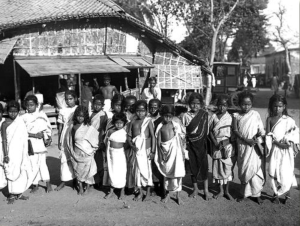
Children. (Source: Old Indian Photos)
Beneath a pale, hot sky that glistens fiercely round the flaming sun, we made our way among the huts, under the stiff plumes of the cocoa-nut palms, along the red, dusty path that led to a bazaar, clustered round the ruins of an old Bengal Raja’s palace. The distant rattle of a wandering juggler’s drum reached us; the clang of an anvil; the loud croak of a purple crow that looked askance at us from the roof-pole of a doorless hut. Faint wreaths of pungent blue smoke tinged the air, mingling with the damp woody odor of bamboos.
A crowd of chattering naked dusty children escorted us, in noisy, delightful excitement, laughing and shouting to us, “Mem Sahib, baksheesh! Ekti paisa do, Sahib! Mem-Sahib, paisa do!” and tripping and tumbling against each other in their eagerness; and one little toddler, a plump coffee-colored boy, decorated with a belt of old coins and keys, constituted himself our bodyguard, and did us signal service by dislodging the gaunt, ugly pariah dogs that howled and snarled at us, but slunk away rebuked before the little fellow’s fat brown fist, or pink, spurning heel, undipped in their dusky Styx.
Once and again have I been walking quietly and as inoffensively as the representative of the conquerors may, in the byways of some Bengali village, and have had my dignity as a Briton and a gentleman all scattered to the winds by a surly Nationalist of a buffalo bull, bearing down on me sniffingly, with sinister intent; then, to rub salt in the wounds of my honor, some Bengali babe, naked but for a key strung round his loins, has come shouting and brandishing a little stick, and has chased the buffalo bull away, its abject tail between its legs. But even worse are the hurts to dignity when one is set on by a pack of pariah dogs—huge howling nondescripts that sniff and snap and snarl at magisterial legs. Verochka never knew much Bengali, counting her towels with her washerman in a Hindi all her own; but she did learn to cry out “Maro kokkur!”—“Beat the dog”—with terror-stricken vigor; whereat the little Bengalis, obedient even while unsympathetic to her fears, took sticks and drove the howling monsters off. If they had only barked, it would have been less uncomfortable, but their one note was a roaring, insolent howl.[1]
Bazaar Fruit-Sellers. (Source: Old Indian Photos)
At last, turning a corner under a quaint old arch, or watch-tower, of crumbling dull red brick, we found ourselves in the sun-steeped bazaar, with long rows of sheds of Hindu artisan and Mussulman merchant ranged on each side of the narrow street, with its heaps of red dust, broken straw, sleeping pariah dogs, and brown, naked children; the whole gay with a bright-clad, laughing throng, that our appearance only stimulated to fresh noise.
The burning air penetrated the whole picture, and gave its colors a brilliancy only seen in eastern lands. As we entered the bazaar, an old village woman, in faded grey muslin sari, squatting on a much worn mat, began screaming to us the virtues of her wares, heaps of green plantains, scarlet chilies, white garlic, blue brinjals, and brown and yellow nameless fruit, ranged round her in a crescent on the mat. At her right hand, and well within sight and grasp, a little pile of dirty coppers, and brown-streaked cowrie shells, the currency of her village wares.
We appeased her by a purchase and calmed the vehemence that lighted up her thousand wrinkles, receiving some carefully counted cowries as our change.
While our bargaining with the old fruit-seller went on, a few craftsmen and shopkeepers left their sheds, and, gathering round us, volunteered advice and criticism, opening up wordy discussions on their own and their neighbors wares. “Come, Mem-Sahib! come to my shop!” cried one, a keen wiry fellow, with bright, restless eyes, the end of his white muslin scarf flung jauntily over his brown right shoulder;—“Come to my shop and see the new stone platters and dishes I have brought from Patna! very nice, bahut achcha! Mem-Sahib!” This last condescendingly in Hindustani, the only native language ladies are supposed to understand. “No, Sahib!” interposed a gaunt, hawk-like, one-eyed man; lean, and with sunken chest. “Come first and see my beautiful Daccai muslins!”
“Your Daccai muslins, indeed!” laughed a third; “why, you weave them here in a back lane and then put Daccai labels on them!” At this the crowd laughed, and the hawk-like man retired discomfited.
“No, Mem-Sahib!” cried another, a silversmith, redolent of his charcoal forge; “come and see my bangles and female ornaments, all made of Company rupees!”
“Come first and see my lamps and Ingreji goods, Sahib! Mem-Sahib says she wants to buy some silver ornaments!” cried the silversmith.[2]
“No! Mem-Sahib says she wants to see my Kashmir cloths,” cried a big, Jewish-featured Kabuli merchant, far paler than the undergrown Bengalis round him. And so on till we were rescued from this babel-din by the arrival of a white-robed, spectacled village schoolmaster, who at once took us under his protection in virtue of having once been a Government clerk; and whose grey hair and semi-official position, supported by an unlimited assumption of dignity, gave him a position of authority amongst the crowd.
He assured us, with a magnificent wave of the hand, that the cloth merchants were low fellows, and that the only shop really worthy of our visit in the bazaar, was the stone-carver’s, an honest fellow, who, by the way, happened to be his brother-in-law. So we were led to the stone-carver’s shed by the sympathetic crowd of shopkeepers, with a penumbra of chattering children, the little schoolmaster being in command. The shopkeepers and artisans deserted their wares to join our crowd, in complete mutual confidence, and with a grand oriental politeness that seemed to say that all their own business, however important, must be laid aside while they minded ours.
When we arrived, the sole occupant of the stone-carver’s shed was a wrinkled, gray-haired woman, with that air of arid antiquity, and shrewish world-weariness that overtakes all low-caste Indian women in early middle age, but withal a cheerful relic, seated on a clean grass mat, and surrounded by tiers of saucers, rice-dishes, and broad platters of grey Patna soapstone, so soft that, when fresh quarried, you can turn it on a lathe, or carve it with a penknife.
Here a noisy diversion was created by the arrival of another old woman, more arid than the first, screaming out imprecations, gesticulating wildly, and evidently bent on doing a mischief on her of the stone platters. “Come, Sahib! listen, Mem-Sahib!” she vehemently cried. “Don’t look at that vile Padma Bibi’s stone platters! Badma Bibi is a base fraud, and may all her dirty platters tumble down and smash her head!” (great applause from the infantile penumbra); “Come, Mem-Sahib! come quick, and see my stone platters! the best in the bazaar! come quick, before it is too late!” (this with a despairing glance over her shoulder).
We were at a loss for the key to this mystery, but our crowd of sympathetic counsellors seemed fully to understand and enter into the dispute. The little old schoolmaster took up the cudgels for Padma Bibi, and bore down on the intruder with his umbrella—the Bengali’s natural weapon of defense, exclaiming:
“Get away, you low-caste woman! Don’t you be trying to interlope into our bargain with your dirty dishes, you! Here comes my brother-in-law! He knows more about Patna stone than anyone in this bazaar!”
The “low-caste woman,” in reply, poured out a torrent of objurgations on the heads of Padma Bibi, the schoolmaster, his brother-in-law, their man-servant and their maid-servant, and then retreated to her own shop discomfited, and growling at the loss of a bargain. Arrived there, she cooled her rancor, and restored her equanimity by puffing vigorously at a dirty hookah, firing from between her lips wreaths of the vilest smelling tobacco smoke in the world, as if every puff were a shot leveled at the heart of the reprobate schoolmaster, or that infamous rival in platters, his fraudulent brother-in-law.
When the brother-in-law arrived, the objurgatory old lady’s eagerness to get possession of us, and her tempestuous uneasiness at his rivalry were justified, for he turned out to be a real connoisseur of stone-carving, and more than deserving of the little schoolmaster’s interested encomiums. After introducing himself as the owner of the shop, and the brother-in-law of the little school-master—once a Government clerk and thereby a distant but determined relation of the British Indian Government in general, and of ourselves in particular, the new arrival began to take down from dusty shelves, little stone figures of Hindu gods, saints, and Yogis, curiously carved, elephant-headed Ganeshas, the milkmaid Radha, her beloved Kisto “Krishna,” seated in contemplation in the Lotus-posture, Mahadevs, Naradas, and a dozen more.
From a dark nook among the rafters he brought out a smoke-stained group of half-a-dozen Rishis, joined elbow to elbow, curiously cut in grey stone, and strongly reminding us of some carved oak panel of medieval saints or apostles. From yet another corner he unearthed some beautifully carved and polished elephants, a few of them exquisitely finished; all diminutive. One little elephant in particular, that held a twisting lotus-stem in his trunk, was altogether admirable as a work of art; the big bosses on his forehead, the skin folds on his flank, the stiffly bent knee, the restless flick of the tail, that almost seemed to move, went as far as the sculptor’s art can go.
Bazaar. (Source: Old Indian Photos)
We could well believe the brother-in-law’s assurance that the little elephant was a hundred years old, for the once grey stone had turned to glossy black with age. But the sculptor’s ideal must have been millenniums old; for never in India now do you see such sleek, well-favored pachyderms; the goodly curves of Leviathan have shrunk and shriveled away with the withering glory of his mother India.
As the stone-carver laid down together on the mat a four-handed, tusked and trunked Ganesh, and this beautifully moulded little elephant, one could not but fall a moralizing on the vast gulf that separates the symbolic sculpture of the high-caste Brahmans from the simple, perfect naturalism of some low-caste artist, such as he who carved this little elephant.
What perverse inspiration was it, what malign whisper of the powers that rule unbeauty, that led the metaphysical Brahmans to embody their transcendental imaginings in cosmology in solid marble and lasting stone? These sculptured nine-fold Ravanas, these seven-headed Serpents, and much-armed Kalis, expressed in stone, are as dissonant and discordant as a chapter on quarternions set to the music of Apollo’s lute.
But for this metaphysical cloud to misguide the sculptor’s chisels, we might have had an Indian school of sculpture, beautiful and natural, as this carved elephant showed, even if rather stiff and solemn than graceful, rather Egyptian than Greek. Even now these sculptured Rishis possess in many things the rudiments, or even considerably developed characteristics, of a true Indian school of sculpture. They embody, with a considerable fidelity, a high type of physical development; the craftsmen have even been able to give them a certain moral dignity and thought; and in their repose and quiescence they strongly remind us of the sculptured dynasties of the Nile.
These Egyptian analogies are frequent enough in Indian sculpture; many of the faces in the bas-reliefs of Elephanta are pure Egyptian in type; and I remember once seeing a native clay-modeller, who had never left his village in a remote corner of Bengal, molding a perfect Sphinx head, Egyptian head-dress and all, under the impression that he was making an idol of the Indian Durga.
Our reflections on the lost school of Indian sculpture were cut short by our guide, the grey-haired pedagogue, who pressed us to conclude our bargain with the brother-in-law, and, at once relieving us of our purchases, entrusted them to the nearest small boy, with instructions to carry them to our tents. Gopal, or Kartik, or whatever his name may have been, was at first reluctant to leave the fascinating bazaar, but at last consented on the understanding that baksheesh was in the wind.
When he disappeared at a run with our treasures, Verochka, who had not understood the arrangement, was aghast at what seemed to be the loss of her spoils; but at last the little pedagogue persuaded her that he was a very good little boy, and would take them quite safe. While Verochka was still unpacified, the small boy appeared breathless and radiant for his baksheesh, averring his intention to spend it on Sandesh, to us, unattractive compound of molasses, rice, and ghee. Then Gopal faded into the penumbra, and we saw him no more. In the evening, however, Verochka found her treasures all safe, and duly delivered; Gopal was vindicated.
From the stone-carver’s shed we turned, still under the guidance of our friendly pedagogue, to a hardware merchant’s store, full of cheap lamps and colored glasses, stoneware, cups and bowls, glass beads and steel watch-chains, for the most part made in Germany or Belgium.
I am sorry to say that our gray-haired, spectacled guide, who was old enough to have known better, and the whole bazaar after him, expressed the warmest admiration for these worthless examples of showy vulgarity, devoid of every artistic or imaginative merit, and I believe nothing but their respect for our superior purchasing power prevented them, in the character of future possible sellers, from expressing openly their contempt at our strong preference for native over foreign wares. The harm that these wretched imported vulgarities do to Indian taste and Indian arts is very great, for the very reason that these arts are no longer creative, but traditional and imitative, and have no inherent vital force of their own to counteract foreign influences and the attraction of showy novelty.
But the harm that globe-trotting buyers do is far greater. To mention a few cases out of many, their uncultivated taste, or rather total absence of any taste whatsoever, has altered, debased, and vulgarized the style of Madras gold thread work, Delhi silk embroidery, Benares brasses, and Murshidabad ivory; so that at present there are in the market two widely different styles of each of these arts, the one old, and rapidly going out of fashion, representing the real traditional artistic expression of the old Indian nations; the other new, and rapidly growing in favor, an exotic medley of neo-romantic æstheticism with old Aryan designs, a monstrous mixture of modern Bond Street and ancient Benares. It was a relief to leave these Belgian novelties, all unpurchased, in spite of our guide’s insistent protestations, and turn to the shed of a clay modeler, whose tastes and methods were still incorrupt.
The modeler, a grizzled little man, with white turban over his smiling brown face, was a genuine enthusiast for his work, and a true artist in his own way. Not content with splendidly modelling little figures of Brahmans, merchants, sepoys, coolies, cultivators, and a dozen others, he even went the length of coloring each with the exact shade of brown, chocolate, or café-au-lait, that race, caste, or occupation had given to each of his subjects. More than this, he even adorned with eyebrows, eye-lashes, beards shaven and unshaven, flowing locks, or single fore-lock, the faces of his subjects according to their caste, age, custom, or personal whim; and he had given so much life and character to his studies that an ethnologist might have learned a great deal from his little figures, about the tribes and races of Lower Bengal.
Here, for instance, was a Brahmin, pale, with large forehead, finely formed nose, sunken chest and narrow shoulders; a Mussulman, evidently from the North-west, darker than the Brahman, with the turban and slippers of Delhi, and the disdainful air of a conquering nation.
Beside them, a sweeper, a low-caste Hindu, far darker than the others, shaven, but with grizzled chin, three days unshaved; turbaned, but without the jaunty air of the Delhi Mussulman, and carrying under one arm the bundle of twigs that marked the occupation of his caste; then a Bengali policeman, in the queer blue uniform and red turban that the Bengal Government prescribes, his face so finely finished that anyone familiar with Bengal could recognize him for a convert to Islam, but of Bengali blood, and not a follower of the conquering Mughals; beside the policeman, a dhobi—an Indian washerman—, a bundle of clean clothes on his back, with disheveled turban, light flowered muslin vest, and with that look of pensive, meek humility that Bengali dhobis have beyond the rest of the human race. Amusing and interesting to us were a series of Indian servants in the garb and habit that Anglo-Indian custom imposes on its domestics.
The whole series of them were there, the butler, Khansamah, with bland, suave visage, every feature breathing consciousness of his importance, and a subdued melancholy in his eyes, telling that he might, an if he would, disclose strange things about his occidental masters; then the bearer, so called, perhaps, because he has to bear much besides the clothes and boots that are the rightful objects of his attention; then the Khidmatgar, the cook, the deputy cook, the syces, and the whole throng of them that live so well and work so badly.
It seemed to us that the modeler turned from these with regret, and even with some slight disdain, to the other branch of his trade, the making, molding and modeling of sundry idols, gods, and goddesses, and dolls, the former for the pious at festival times, the latter for the little dusky wights of our penumbra. There were Naradas, Durgas, Kalis, Rishis, Krishnas, Hanumans, and so on, carelessly moulded and bedaubed with red and yellow and blue, their turbans and robes included in the clay, and not delicately fashioned of fine muslin, like the scarfs and head-gear of the modeled natives.
The dolls were strange beyond imagining; mere red columns of clay, with nobs for arms, ears and noses, and strange conical headdress of clay, painted shiny black. These grotesques at first gave me a poor opinion of native infant intelligence, that would allow itself to be put off with such an apology for a plaything; but when Verochka pointed out that it was greatly to the honour of their imagination that the little Bengalis could build on such a slender basis an imagined thing of beauty and a likeness of the human race.
We bade farewell reluctantly to the gay little modeler, not unfurnished, however, with specimens of his skill.
Next door to the clay-modeler, if one may say so of open sheds that had no door, a withered little man for almost all Bengali artisans are small of stature plied one of the strangest arts that even that wild, out of the way bazaar could boast of. He was a maker of the shell bracelets used in sets of four in the Hindu ceremony of betrothal; he cut them delicately with a fine steel saw from the great white conch or shankh shells of the Indian ocean. Then, carefully polishing them, a line or two of vermillion, with delicate penciling in yellow, a hole pierced to bind the four together, and the shell bracelets were ready to manacle the dusky little Durgis and Padmas securely for this world and the next. The penciling on these shell bracelets are very curious; they seem, with the runic cross marks on the edge, to bear some mystic meaning, the tale of some old talisman, once religiously believed in and dreaded, but now long since forgotten. The tinkle tinkle of the four fold bracelets of shell on the little brown arms is very pretty and musical. After the shell-cutter, our guide took us, still followed by the interested, noisy crowd, with its fringe of merry children, to the workshop of a Kanchari, or worker in white brass. With evident pride in his occupation, he told us that his family had for generations belonged to the brass-working guild of Khagra, a suburb of Berhampore, where they make the finest white brass work in Bengal, and, indeed, as our Kanchari told us, in the whole universe. The mainstay of his trade was the manufacture of those brass bowls and platters, goblets, and cups which, for food and for devotion, have filled an all-important part in Hindu households since the days of the old law-giver Manu. Without them, no Hindu could duly perform his daily ablutions and prayers, or eat the chaul and dal that his caste rules prescribe. Without them his mate and helpmeet would be deprived of the most important of her daily tasks—the burnishing and polishing of these cups and platters by the riverside in the morning, before the sun has heated to burning the yellow sand that borders on the stream.
A charming picture they make every morning, on some stream of the holy Ganges, these groups of Hindu women, in their bright muslin saris, busily burnishing the shining brass, by the edge of the blue, calm water, mirroring the temples and palms on its bank; and the high-prowed native craft that float lazily down with the languid stream; when the clang of the oar in the row-lock, and the blade’s dull splash in the water echo gong-like over the quiet stream, and, ever and anon, some snatch of a boatman’s song, weird, musical, unearthly, completes the magic of the picture.
How they make this white brass is uncertain, though tradition says it contains some silver, like the Moscow bell-metal of old; the red ingots of copper are brought in bullock-carts from the boats that lie by the wharves of the river-ports on the Ganges and its streams.
Besides these main subjects of his trade, the Kanchari made and painted little brass spice boxes, cups and trays, whose uses were mostly unintelligible to us; and, yet another branch of his art, little brazen gods and goddesses and heroes repeated again the types we had already seen in stone and clay. While the brass-worker and the little schoolmaster were initiating me into the kindred and relationship of all these Ganeshas, and Durgas, and Mahadevs, I noticed that Verochka, weary of mythology, had disappeared. For a minute or two there was no clue to her whereabouts, but a laughing, noisy crowd round the dokan of the Kashmiri cloth merchant, who had fallen under the little pedagogue’s displeasure when we first entered the bazaar.
Leaving the brazier’s shop, and joining the crowd at the Kashmiri’s door, I saw Verochka, in the dark recesses of the shop, gravely discussing with the tall merchant the merits of certain Persian printed cloths which, it seems, she had unearthed from under his bales of Indian muslins.
The objects of discussion lay unfolded on a clean grass mat on the floor; the Kashmiri on one side gravely held up both hands, with fingers spread, to signify the rupees; Verochka, on the other, with equal gravity held up three fingers to indicate her valuation of the Persian prints. The Kashmiri shrugged his shoulders, raised his eye-brows, and evinced other oriental signs of surprise at the “ridiculous” offer made to him for his wares. “Don’t pay the rupees, Mem-Sahib! Very much dear!” whispered the little schoolmaster mindful of his former animosity, and struggling with a very evident fear of the tall broad-shouldered native of Kashmir. “Kashmiri people very thieving people, Mem-Sahib! don’t buy that dirty old Parsi cloth! Look! buy one of these nice Bilate shawls.[3] See, I have got one of them myself” proudly showing a cheap German textile, then the fashion in the bazaars; “and all the Bengali gentlemen wear them now.”
Beside these German shawls were several rolls of green and scarlet baize, the former evidently destined originally to furnish billiard-tables; it had, however, caught the popular taste, and almost threatened to oust German shawls in the most fashionable circles of Bengali gentlemen. Since then I believe, green and scarlet baizes have become more and more “distinguished” for ordinary bazaar and collegiate wear.
Verochka, however, resisted the little pedagogue’s blandishments, and hardened her heart to the enticements of Hamburg and Elberfeld novelties, and at last, after ten minutes hard bargaining, managed to get the pair of Persian cloths for five rupees, evidently to the discomfiture of the Kashmiri, who, however, did not like to hold out, in view of possible further purchases. Evidently the Kashmiri was unpopular in the bazaar, for the crowd vented its admiration of Verochka’s victory and his defeat as clamorously as it dared, in view of the strong arm of the, to them, gigantic north-country man.[4]
Little Gopal, who had brought the stone carvings to our tent, was so carried away by the sense of his new importance as our trusted and baksheeshed messenger, that, forgetful of fear, he cried out “Well done! Mem-Sahib! Very good, Mem-Sahib! the Kashmiri thief is cheated this time!” After pride comes a fall, however; for, in spite of a quick and strategic retreat, little Gopal did not escape the slipper that the Kashmiri leveled at his dusky vanishing back.
“Keep away, you low people!” cried the Kashmiri. “Have you manners! Mem-Sahib can’t see my cloths and all the fine things in my shop if you crowd in front of the door!”
Then the Kashmiri brought out some girl’s saris of Dacca muslin, dyed in indigo, safflower, and cochineal, and hand-woven on the native looms; not the true Dacca muslin, however, a large piece of which you can pass through a finger-ring, it is so fine, but a stronger, more durable material. These girl’s saris were simply strips of muslin, two or three yards long, and half a yard wide, with bright flowered designs, worked into more complicated patterns at the end. Each piece was a complete gala costume for the little Bengalee girls of eight or nine; a turn or two round the waist for the skirt, then the end passed under the left arm, and over the right shoulder, and the pretty robe is complete. Nothing can be more graceful than one of these pretty muslin saris, its folds falling pendulous, like the drapery of a Grecian statue.
Designs there were many; white flowering carried diagonally across a pale green ground; pale blue and rose on a ground of white; and pale green, red and yellow on a ground of indigo.
Unluckily these hand-woven muslins are becoming rarer and rarer; the daintiest designs and textures are vanishing into the past; the old “sunshade” and “peacock’s neck” patterns are becoming traditions, in order that Hans Schmidt of Hamburg may heap up thalers for his green and scarlet baize.
Certain transactions in saris went far to justify the Kashmiri’s policy in parting with the Persian cloths for too small a price. The little pedagogue began to grow uneasy lest, in the magnitude of our purchases, the Kashmiri should leave the “brother-in-law” behind.
“Look, Mem-Sahib!” said the Kashmiri, visibly warming to his work. “Here are some fine silk embroideries from my own country, and from Delhi and Benares. The girls of my country sew them on a frame, and their soft hands move as swiftly as the gold fish in Shing-Shu Hai! Here is a very nice silk embroidery! Look at it, Mem-Sahib! buy it, Mem-Sahib! this is from my own country, from Kashmir, all hand-embroidered! Very good! Mem-Sahib! Look at the sepoys and horses in red and white silk, and look at the green palm leaves, and the Hindu women, with the faces and saris. Very good embroidery! None like that in Bilait, Mem-Sahib! Sahib says, ‘take it,’ Mem-Sahib. Very nice embroidery,” and Verochka gave in.[5]

Bazaar. (Source: Old Indian Photos)
“And look at this Delhi enamel work! nice gold thread on grey satin, and a pheasant and butterflies in colored silk! My country is a fine country—far better than Bengal or Delhi!” cried the Kashmiri, with a burst of patriotism, “but for all that,” he continued, patriotism giving way before trade “but for all that, we can’t make enamel-embroidery like Delhi! Lovely piece of work, Mem-Sahib! best piece of enamel embroidery in the world! Look at the pheasant’s red beak, and yellow neck and green back, and look at the purple butterfly among the golden leaves! Very fine embroidery, Mem-Sahib!”
Again Kashmir prevailed.
Then a new idea seemed to strike the merchant:
“Very nice watch you have, Mem-Sahib! I’ll give you fifteen rupees for it! Will you, Mem-Sahib?”
The Kashmir received a rebuff, and for several minutes seemed to be puzzling over the failure of his bargain; then, turning away to hide his mortification, he went to the other side of the shop, to bring a box of cut agates and jaspers from Amritsar.
He showed us Himalayan pebbles, brown, chocolate, and grey, cut in oval brooches; studs, earrings, and breastpins, all of fine cut pebbles, but with curious inconsistency mounted in hideous brass settings.
Prettier still, because unmounted, were a set of fruit knife handles of agate, jade, malachite, fine-grained conglomerate, with veins of dark green and red; one beautifully cut and polished with a fairy spray of moss agate curving round the side.
Kashmir was again victorious. The little Bengali pedagogue, who had served us zealously, if not quite disinterestedly, began to grumble at our inconsistency in buying so much from a low Kashmiri, and finally left us in disgust and went to pour out his wrongs in the sympathetic ear of his brother-in-law and to revive his drooping spirits with a whiff of the pungent hookah. I am afraid he never forgave us for patronizing the Kashmiri with more enthusiasm than we had shown his brother-in-law, “who knew more about Patna stone than anyone else in the bazaar.”
At last our bargains were ended. The Kashmiri presented Verochka with a green pebble brooch, “for baksheesh,” as he explained, and begged in return a German half-mark, which would, he assured us, bring him luck in the future bargains.
With salaams, we left him, and, tired out by the scorching Bengal sun, were glad enough to find our way to the tents; in the shade of a grove of giant mango trees, where the grey squirrels disport themselves on the branches, and the turtle-doves croon strange tales to each other among the glossy leaves.[6]
← Table Of Contents →
SOURCES:
[1] Johnston, Charles. “Helping To Govern India: Kandi Subdivision.” The Atlantic Monthly. Vol. CIX, No. 2. (February 1912): 265-273.
[2] “Ingreji” = English.
[3] “Bilate” = European.
[4] Verochka writes: “Lovely things are sold in every little shop in India, on all the railways, and are so cheap that there was nowhere for an apple to fall in my suitcases and chests.” [Johnston, Vera. “Home From India.” Russian Review. (May 1891): 245-278.]
[5] “Bilait” = Europe.
[6] Johnston, Charles. “Curio-Hunting In A Bengal Bazaar.” The Calcutta Review. Vol. CXCIII, No. 193. (July 1893): 1-12.




